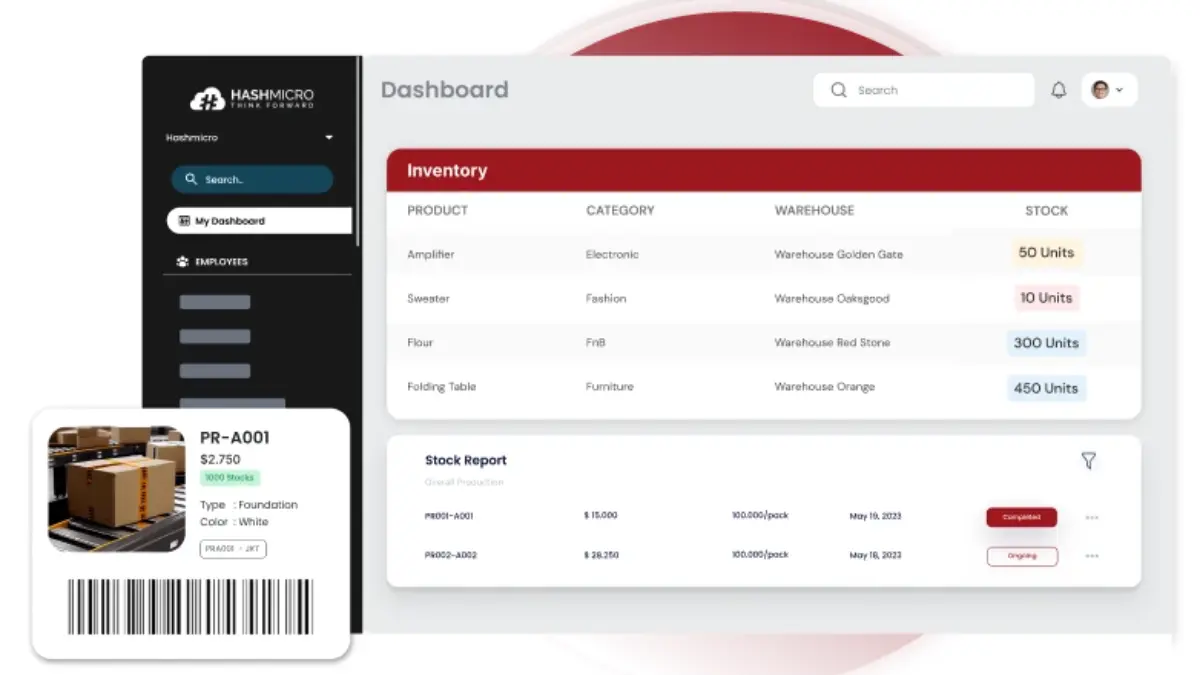Inventory reconciliation involves comparing the actual physical inventory with the recorded inventory levels. This process is crucial because it helps minimize stock discrepancies and provides insights into the reasons behind any differences.
Without accurate tracking, managers can face significant inventory problems, such as running out of stock or having excess inventory, leading to lost sales and increased storage costs. Poor inventory management can also result in unreliable data, making it difficult to make informed decisions regarding ordering, sales forecasting, and budget planning.
Implementing the right software is crucial to overcoming these challenges. A recent survey conducted by SGTech revealed that 80% of companies in Singapore had adopted automation solutions to address productivity and labor issues.
Understanding the critical steps in inventory reconciliation ensures your business’s success. By following these steps, you can enhance operational efficiency and significantly impact your business in Singapore.
Table of Content:
Table of Content

Key Takeaways
|
What is Inventory Reconciliation?
Inventory reconciliation is the act of taking inventory of everything you have and making sure your stock records match reality. It’s important to reconcile your inventory periodically to find any discrepancies that need to be addressed.
Differences in inventory often arise from recording mistakes, damaged goods, or stock losses. However, by regularly performing inventory management software, companies can maintain accurate data and prevent potential losses.
Moreover, reconciliation plays a crucial role in helping managers make well-informed decisions about stock management. This process also enhances operational efficiency by ensuring inventory is consistently and accurately monitored.
How Inventory Reconciliation Enhanes Business Operations
Inventory reconciliation plays a vital role in ensuring the smooth functioning of business operations. By regularly aligning physical inventory with digital records, businesses can maintain accurate stock levels, directly impacting their ability to meet customer demand.
Moreover, consistent inventory reconciliation helps identify and address discrepancies early on, such as shrinkage due to theft, damage, or administrative errors. By catching these issues before they escalate, businesses can take corrective actions that protect their assets and improve profitability.
Ultimately, practical logistic management software boosts operational efficiency by providing reliable data for better decision-making. With accurate inventory information, businesses can optimize their purchasing, sales, and warehouse management strategies while reducing unnecessary costs and supporting sustainable growth.
7 Steps Involved in Inventory Reconciliation
Managing inventory reconciliation is critical to maintaining accurate stock levels and ensuring smooth business operations. By following a structured approach, you can effectively identify discrepancies and keep your inventory data reliable.
Here are seven essential steps to guide you through the inventory control system process and help you achieve optimal results.
1. Choose your inventory reconciliation method
Start by selecting the correct reconciliation method for your business. Depending on your inventory size and transaction frequency, you can opt for daily, weekly, or monthly reconciliations. Each method has pros and cons, so choose one that balances accuracy and efficiency. This decision sets the foundation for a smooth reconciliation process.
Moreover, if you use inventory reconciliation automatically, then your business process management will be very efficient. Especially, using the best inventory management software in Singapore from HashMicro, you can get automation efficiently and accurately.
2. Count your physical inventory
Next, conduct a thorough count of your physical inventory. This step is crucial for gathering accurate data that reflects the actual situation on the ground. Ensuring that every item is accounted for is essential, so take your time to count everything carefully. Accurate physical counts are the backbone of effective inventory management.
3. Compare physical counts and digital records
After counting, compare the physical inventory with your digital records. Look for discrepancies between what is physically present and what your system shows. This step helps you identify potential errors or issues that must be addressed. Doing this regularly ensures that your inventory records are always accurate.
4. Identify missing items and sources of discrepancies
If there are differences between physical counts and digital records, identify the missing items and understand the reasons behind these discrepancies. Investigate common causes such as human error, theft, or damaged goods. Knowing where things go wrong allows you to take targeted corrective actions. This step is crucial in preventing future discrepancies.
5. Record discrepancies and reconcile your inventory
Document any differences you find and adjust your inventory records accordingly. This reconciliation process ensures that your digital records accurately reflect the current stock levels. Recording these adjustments helps maintain transparency and accountability within your inventory system. This step finalizes the reconciliation and prepares you for the next cycle.
6. Take corrective action
Address the root causes of any discrepancies you identified. Implement solutions such as improving staff training, enhancing security measures, or upgrading inventory tracking technology. Taking corrective actions helps prevent the same issues from recurring. This proactive approach strengthens your inventory management over time.
7. Routinely reconcile inventory
Finally, make inventory reconciliation a regular part of your business operations. Whether daily, weekly, or monthly, routine reconciliations help maintain accurate inventory records and catch discrepancies early. Consistency is critical to long-term inventory accuracy. By staying diligent, you ensure smooth operations and avoid costly surprises.
Benefits of Performing Regular Inventory Reconciliation
Regular inventory reconciliation is more than a routine task; it’s critical to effective business management. By consistently aligning your inventory records with actual stock levels, you can prevent costly errors and optimize your operations.
Let’s explore the key benefits of inventory control system can bring to your business.
1. Accurate inventory reports and data
Conducting regular reconciled inventory ensures that your reports and data accurately represent the actual state of your stock. Maintaining precise records is critical for making well-informed business decisions, from purchasing to sales strategies.
By consistently verifying your inventory, you can prevent discrepancies that may lead to costly mistakes or poor judgment.
Moreover, accurate data facilitates better communication across departments, ensuring that everyone has access to reliable information. This transparency not only strengthens your business operations but also supports a smooth and efficient workflow.
2. Improved demand forecasting
When your inventory data is consistently accurate, your demand forecasting becomes much more reliable. Regular reconciliation allows you to track trends and patterns in your inventory, enabling you to predict future demand with greater precision. This proactive approach ensures better planning and resource allocation, which in turn reduces the likelihood of stockouts or overstock situations.
In addition, improved forecasting directly contributes to higher customer satisfaction by ensuring that the right products are available when needed. By keeping your inventory aligned with market demand, you can optimize both sales and profitability.
3. Mitigated shrinkage risk
Inventory shrinkage, whether due to theft, damage, or administrative errors, can have a significant impact on your bottom line. Regular reconciliation plays a key role in mitigating this risk by identifying discrepancies early on. Addressing shrinkage promptly helps prevent minor issues from escalating into significant financial losses.
Furthermore, by understanding the root causes of shrinkage, you can implement targeted strategies to reduce it—such as enhancing security measures or improving inventory handling processes. This not only protects your assets but also contributes to a more efficient and cost-effective operation.
4. Updated safety stock levels
Maintaining appropriate safety stock levels is essential for balancing supply and demand. Regular inventory reconciliation ensures that your safety stock is always up-to-date and accurately reflects actual consumption rates and lead times.
Additionally, with properly managed safety stock levels, you can minimize the need for costly emergency orders. This improved efficiency leads to better cash flow management and more excellent overall business stability.
5. Identify theft and fraud
One significant advantage of regular inventory reconciliation is its ability to detect theft and fraud within your organization. By routinely comparing your physical inventory against records, you can identify suspicious discrepancies that may signal fraudulent activity.
Early detection enables you to take swift corrective action, thereby minimizing potential losses and safeguarding your business. Moreover, addressing theft and fraud helps create a secure and trustworthy work environment. This vigilance not only protects your assets but also fosters a culture of accountability and integrity within your team.
3 Methods for Performing an Inventory Reconciliation
Practical inventory reconciliation is essential for maintaining accurate stock levels and ensuring smooth business operations. To achieve this, it’s essential to choose the right approach that suits your business needs.
Below, we’ll explore three proven methods for performing inventory reconciliation that can help you maintain accuracy and efficiency.
1. Checking inventory seasonally
Seasonal inventory checks are a strategic approach that allows businesses to reconcile their stock during specific times of the year, often aligned with peak seasons or major sales events. This method benefits companies with fluctuating inventory levels, ensuring that stock levels are accurate before high-demand periods.
By scheduling inventory checks during crucial business seasons, you can avoid discrepancies that might disrupt your operations.
Moreover, seasonal checks help identify trends in inventory usage, allowing for better forecasting and planning. This proactive method ensures that your inventory is well-prepared to meet market demands, ultimately enhancing customer satisfaction and minimizing stockouts or overstock situations. Using a cloud based inventory system can further improve this process by providing real-time insights and automating reconciliation.
2. ABC method
The ABC method involves categorizing inventory into three groups—A, B, and C—based on their value and impact on the business. Category A consists of high-value items crucial to your operations and should be reconciled more frequently.
Category B includes moderately valuable items, while Category C comprises low-value products requiring less frequent checks. This method prioritizes resources where they matter most, ensuring that critical inventory is always accurate.
The ABC method helps businesses allocate their time and resources efficiently by focusing more on high-value items. This targeted approach reduces the burden of reconciling the entire inventory simultaneously and ensures that your most important assets are always under control.
3. Checking at random
Random inventory checks, also known as spot checks, add an element of unpredictability to the reconciliation process. This method involves performing unannounced inventory counts on random items or sections of the warehouse.
Random checks are particularly effective in identifying and addressing discrepancies that may not be caught during scheduled reconciliations. By keeping staff alert and diligent, this method helps maintain the overall accuracy of inventory records.
Additionally, random checks can be integrated into other inventory management processes, such as cycle counting or during routine audits. This flexibility makes random checks valuable in ensuring that your inventory remains accurate and up-to-date without requiring extensive resources.
Inventory Reconciliation Tips
Effective inventory reconciliation is essential for maintaining accurate stock levels and ensuring smooth business operations. Implementing practical strategies can significantly reduce errors and save time, making this process as efficient as possible.
Here are some valuable tips to help you streamline your inventory reconciliation efforts and achieve better results.
- Use inventory management software: Implement inventory management software to automate tracking and reduce manual errors, ensuring accurate and up-to-date records.
- Use barcode scanners: Utilize barcode scanners to speed up counting and minimize human error, seamlessly integrating with your inventory management system.
- Organize inventory before counting: Organize your inventory by categories or locations before counting to streamline the process and ensure accurate reconciliation.
- Regularly count inventory: Conduct regular inventory counts to catch discrepancies early and maintain accurate stock levels, preventing overstock or stockouts.
- Compare your shrinkage rates after each count: Analyze shrinkage rates to identify and address any loss patterns, improving overall inventory management.
Improve Your Inventory Reconciliation with HashMicro’s Inventory Management Software
HashMicro is the leading ERP software provider in Singapore. It is trusted by businesses of all sizes across diverse industries to streamline their inventory management processes. With a proven track record, HashMicro helps companies achieve greater efficiency and accuracy in managing their inventory.
If you want to learn more about how HashMicro’s inventory management software can benefit your business, you can try a free demo with our professional team. This hands-on experience will give you a deeper understanding of the software’s capabilities and how it can be tailored to your specific needs.
Below, we will explore inventory management software comprehensive features to enhance business efficiency, such as:
- RFID Warehouse Rack Stock In-Out Automation: Automating the tracking of stock movements in and out of warehouse racks significantly enhances inventory management efficiency and accuracy. This technology ensures that every item is precisely monitored, reducing errors and saving valuable time.
- Stock Forecasting: Proactively managing stock levels through forecasting optimizes inventory and boosts customer satisfaction. By predicting demand, businesses can maintain the proper inventory levels, avoiding both shortages and excesses.
- Run Rate Reordering Rules: Establishing reorder rules based on market trends ensures the warehouse maintains adequate stock levels to meet demand without overstocking. This approach keeps your inventory balanced, preventing unnecessary costs and shortages.
- Fast Moving Slow Moving Stocks Analysis: Analyzing fast and slow-moving stock helps identify products with high and low turnover rates, enabling strategic planning like prioritizing restocks, launching sales promotions, or phasing out slow sellers. This insight allows for better resource allocation and inventory management.
- Stock Reservations & Reporting: Ensuring the availability of desired items through effective stock reservations and detailed reporting enhances inventory management efficiency. This process guarantees that critical stock is always on hand, improving operational flow and customer satisfaction.
- Quality Control Management: Establishing and managing quality standards for every product stored in the warehouse ensures that only top-quality items are processed. This involves scheduling regular quality checks, inspecting incoming and outgoing goods, and identifying defective or non-compliant products.
These features are designed to support your business’s unique requirements, ensuring that inventory management is effective and seamless.
In addition to these features, HashMicro stands out with its exceptional flexibility in customizing solutions and integrating with various modules and third-party systems. This adaptability ensures that the software can be tailored to meet the specific needs of any business, driving efficiency and success in today’s competitive market.
Conclusion
Understanding inventory reconciliation is key to managing a company effectively. By following the steps in this article, businesses can maintain accurate inventory records, avoid costly mistakes, and improve their operations.
One of the best solutions for Inventory Reconciliation is HashMicro’s software, which offers a wide range of features designed to optimize inventory management. With its advanced automation, customizable options, and seamless integration capabilities, HashMicro provides an efficient and reliable solution for businesses of all sizes.
To experience the benefits firsthand, try a free trial system and consult with HashMicro’s professional team to find the right solution tailored to your business needs.







































